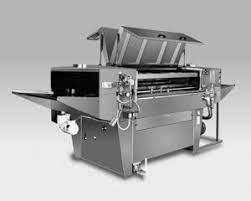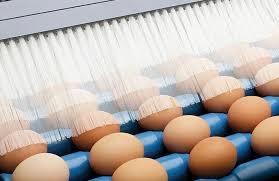 Egg washing, a necessary food safety procedure, has been in regular use in the U.S. since the 1970s. Prior to the USDA mandate to wash eggs, outbreaks of salmonellosis were attributed to a combination of shell contamination and defects. Deposition of motile pathogens onto the surface of the egg as it passed through the cloaca will result in penetration of the shell through pores and
Egg washing, a necessary food safety procedure, has been in regular use in the U.S. since the 1970s. Prior to the USDA mandate to wash eggs, outbreaks of salmonellosis were attributed to a combination of shell contamination and defects. Deposition of motile pathogens onto the surface of the egg as it passed through the cloaca will result in penetration of the shell through pores and  cracks. This represents a potential source of internal infection of the egg even if the internal shell membrane inhibits movement into the albumen. After egg washing was mandated in the U.S. the incidence of egg-related salmonellosis fell sharply until the emergence of vertically transmitted Salmonella Enteritidis in the 1980s
cracks. This represents a potential source of internal infection of the egg even if the internal shell membrane inhibits movement into the albumen. After egg washing was mandated in the U.S. the incidence of egg-related salmonellosis fell sharply until the emergence of vertically transmitted Salmonella Enteritidis in the 1980s
The FDA Egg Safety Final Rule published in the Federal Register in July 2009 mandated egg washing as an adjunct to other measures to prevent Salmonella Enteritidis. Since late 2010, there has not been a documented case of SE infection from a flock conforming to the requirements of the FDA Final Rule. Procedures for effective egg washing are incorporated in the FDA Final Rule and in State Egg Quality Assurance programs. The Standard Operating Procedures of a branded egg cooperative distributing nationally, specifies temperature, pH and concentration of chlorine sanitizer to achieve optimal safety and quality.
With the transition to cage-free housing using either aviaries or slat-and-litter floor systems or allowing outside access, it is evident that a higher proportion of eggs entering packing plants have fecal soil or litter particles adherent to shells. It is obviously necessary to remove foreign material that is readily detected using modern installations leading to downgrading.
Losses attributable to dirt on shells has a significant financial impact. In a complex housing one million hens in aviaries, with a hen-day average of 79 percent, each one-percent increase in downgrade is equivalent to a loss of 658 dozens per day. If the graded, but unpacked, value of cage-free eggs is $1.30 per dozen, the loss through disposal as breaking stock at $0.60 per dozen would be $0.70 per dozen. This represents a loss of $168,120 per year for each one percent downgrading due to “dirties”. Effectively due to floor eggs and eggs that hang up in the modules of aviaries, or are contaminated on elevators and conveyors the loss due to imperfectly cleaned eggs may exceed three percent in many installations.
 The importance of effective cleaning has received more attention recently. Each of the sequential stages comprising prewetting, washing with a detergent-sanitizer, rinsing and drying have been the subject of refinement in the design of equipment and correct operation.
The importance of effective cleaning has received more attention recently. Each of the sequential stages comprising prewetting, washing with a detergent-sanitizer, rinsing and drying have been the subject of refinement in the design of equipment and correct operation.
Kuhl Corporation has upgraded their WEB series of washers that incorporate design features providing satisfactory results over four decades. Kuhl washers are available in capacities up to 1,000 cph and can eliminate 99 percent of surface bacteria when used in accordance with recommended levels of chlorine-based detergent-sanitizer. Kuhl washers incorporate scalloped, horizontal-moving nylon strips on the brushes. Kuhl washers allow adjustment of brush height and incorporate a traveling filter system. For U.S. packing plants Kuhl washers are generally specified for European grading installations since they are compatible with imported equipment.
It is noted that in the U.K. and the E.U. eggs are not washed. This is based on the invalid perception that the outer cuticle (bloom) protects eggshells from penetration by motile bacteria. Washing of eggs to remove contamination with adherent bacteria removes the bloom, hence the disinclination of regulators to allow washing. The validity of the U.S. food safety approach based on effective washing is confirmed by the lack of infections attributed to contaminated egg shells processed in commercial packing plants. The higher standard of food safety in the U.S. from washing is complemented by mandated refrigeration from packing to point-of-sale, a requirement currently ignored by E.U. regulators contrary to volumes of research advocating a cold chain.
Kuhl Corporation can provide technical information and recommendations to design plants and to specify washing and drying equipment for either new installations or as retrofits to existing graders to enhance efficiency and to minimize losses. The Company can be accessed by clicking on to the Kuhl logo on the right side of the Welcome page